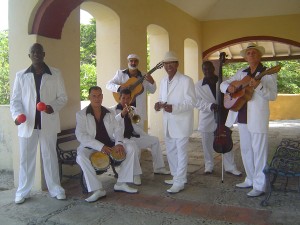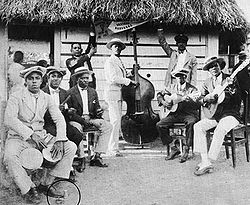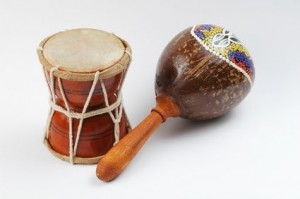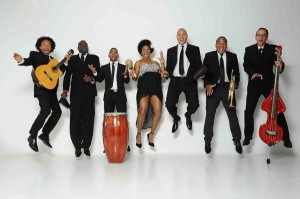 MUSICA CUBANA: PARA TOCAR “EL SON”, HAY QUE LLEVARLO EN EL CORAZON ! ..”
MUSICA CUBANA: PARA TOCAR “EL SON”, HAY QUE LLEVARLO EN EL CORAZON ! ..”
Un género vocal, instrumental bailable, el Son constituye una de las formas básicas dentro de la música cubana.
Presenta en su estructura, elementos procedentes de las músicas africanas (Bantú) y españolas, pero ya fundidos en lo cubano, confluyendo en l giros rítmicos, estribillos, modos percutivos, entonaciones y sonoridades de las cuerdas pulsadas que denuncian sus dos fuentes originarias.
Se baila por pareja enlazada, y para producir su música se emplea una amplia gama instrumental que puede ir de un simple tres o guitarra, a veces acompañado de marimbuela, güiro y bongó, hasta grupos más grandes y complejo.
Por su extracción, desarrollo, características sonoras y coreográficas y su uso social, el son cubano devino históricamente como el medio de expresión más idóneo y representativo para las capas humildes de la estructura socio-económica-política de la Cuba de la primera post-guerra
El son se trasladó de Oriente a la Habana sobre 1909 llevado a la capital por los soldados del Ejército Permanente, en un proceso de transculturación que determina la entrada en la región oriental de la rumba. La incorporación del género a las orquestas danzoneras, al componer José Urfé, en 1910, su danzón ‘El bombín de Barreto’, adicionándole un motivo de son a su parte final, y el surgimiento del legendario Sexteto Habanero, en 1920, y posteriormente Septeto Nacional, le dieron enorme auge al son cubano.
Bailado inicialmente en accesorias, solares y academias de baile por capas populares – los estratos burgueses lo rechazaron y el gobierno llegó a prohibirlo por considerarlo inmoral – los salones de baile de La Habana, y de las ciudades importantes, tuvieron que abrirle sus puertas, y las casas impresoras de discos le dieron una difusión ilimitada.
Inicialmente los grupos de son estaban formados por guitarra, tres, bongó, botija o marimbuela (luego bajo), claves y maracas; después se le agregó una – o ms – trompetas.
Actualmente el formato para interpretar el género es ilimitado.
El son ha reunido numerosas variantes, algunas con personalidad casi independiente. Urfé menciona: “El son montuno;el changüí; el sucu-sucu; el ñongo;la regina; son de los permanentes; la bachata oriental; el son habanero; la guajira son; la guaracha son; el bolero son; el pregón son; el son guaguancó; el mambo; y el chachachá.”
El son cubano suele ser ubicado dentro del complejo sonero del area del Mar Caribe.
La presencia de este género cubano es importante – y creciente -, a escala universal, dentro de las expresiones musicales mas auténticas y valiosas de hoy.

Ayer, Hoy, Siempre- www.THE CUBANHISTORY.COM-Yesterdays, Today, Always.
 CUBAN MUSIC: TO PLAY “THE SON” YOU HAVE TO HAVE IT IN YOUR HEART !..”
CUBAN MUSIC: TO PLAY “THE SON” YOU HAVE TO HAVE IT IN YOUR HEART !..”
Vocal genre, danceable instruments, “The Son” is one of the basic forms of Cuban music.
Presents in its structure, elements from the African (Bantu) and Spanish music, but already melted into the Cuban, coming together in the rhythmic turns, refrains, percussive modes, intonations and sonorities of the plucked strings that denounce their two original sources.
It is danced by a linked couple, and to produce their music a wide range of instruments is used, ranging from a simple tres or guitar, sometimes accompanied by marimbuela, güiro and bongo, to larger and complex groups.
Due to its extraction, development, sonorous and choreographic characteristics and its social use, the Cuban son became historically the most appropriate and representative means of expression for the humble layers of the socio-economic-political structure of Cuba in the first post-war period.
The son was moved from the East to Havana on 1909 brought to the capital by the soldiers of the Permanent Army, in a process of transculturation that determines the entry into the eastern region of the rumba. The incorporation of the genre to the danzoneras orchestras, when composing José Urfé, in 1910, his danzón ‘El bombín de Barreto’, adding a son motif to his final part, and the emergence of the legendary Sexteto Habanero, in 1920, and later Septeto National, they gave a huge boom to the Cuban son.
Initially danced in accessory, solar and dance academies by popular layers – the bourgeois strata rejected it and the government came to prohibit it as immoral – the dance halls of Havana, and of the important cities, had to open their doors, and the album printers gave him an unlimited diffusion.
Initially, the groups of are were formed by guitar, tres, bongo, botija or marimbuela (then bass), claves and maracas; then one – or more – trumpets was added.
Currently, the format to interpret the genre is unlimited.
The son has gathered many variants, some with an almost independent personality. Urfé mentions: “El son montuno, changüí, sucu-sucu, ñongo, regina, are permanent, the eastern bachata, the habanero Son, the guajira Son, the guaracha Son, the bolero Son, el pregón Son and the guaguancó, the mambo, and the chachachá. ”
The Cuban son is usually located within the sonero complex of the Caribbean Sea area.
The presence of this Cuban genre is important – and growing -, on a universal scale, within the most authentic and valuable musical expressions of today.
Agencies/ Cuban Music/ Helio Orovio/ YouTube/ Internet Photos/ Arnoldo Varona/ www.thecubanhistory.com
THE CUBAN HISTORY, HOLLYWOOD.

Ayer, Hoy, Siempre- www.THE CUBANHISTORY.COM-Yesterdays, Today, Always.



 < MUSICA CUBANA: Para Tocar "EL SON", hay que llevarlo en el Corazón !. VIDEOS.
< MUSICA CUBANA: Para Tocar "EL SON", hay que llevarlo en el Corazón !. VIDEOS.




